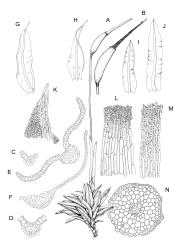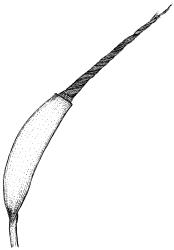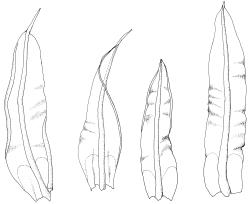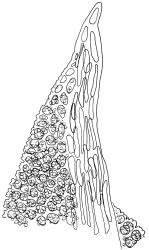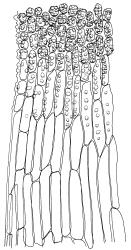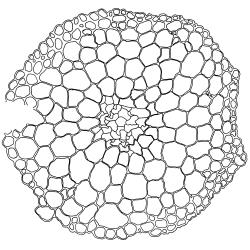- ≡ Tortula calycina (Schwägr.) Hook. & Grev., Edinburgh J. Sci. 1: 291 (1824)
- ≡ Tortella calycina (Schwägr.) Dixon, Bull. New Zealand Inst. 3: 124 (1923)
- = Tortula walkeri R.Br.bis, Trans. & Proc. New Zealand Inst. 30: 406 (1898)
Plants yellow-green above, brown to black below, forming loose tufts. Stems 5–30 mm, branched, the taller plants copiously tomentose, in cross-section with a central strand and sclerodermis present, hyalodermis absent. Leaves erect-spreading and variably undulate when moist, erect, incurved or individually twisted, sometimes twisted around the stem when dry, 2–3 mm, oblong-lanceolate from a broad, strongly sheathing base, broadly channelled, acute; margins plane throughout or incurved above, crenulate-papillose; upper laminal cells obscure, isodiametric to elliptic, often oblate, thick-walled and collenchymatous, densely pluripapillose, (7.5–)10–14(–15) × (9.0–)10.5–12.0(–13.5) μm; upper marginal cells shorter but not forming a distinct border; lower laminal cells strongly differentiated, gradually transitioning from upper laminal cells, hyaline, rectangular, lax and thin-walled, smooth, not differentiated at margins, but with several rows adjacent to the costa often linear, thick-walled, golden and uniseriately papillose. Costa stout, concolorous, excurrent as a short or long arista, sunken in a shallow groove adaxially; adaxial and abaxial superficial cells similar to adjacent laminal cells. Laminal KOH colour reaction yellow.
Perichaetia with leaves conspicuously sheathing the seta base, the inner leaves strongly differentiated from vegetative leaves, appressed, acuminate from a long, tightly convolute base, with laminal cells vermicular and weakly prorate. Perigonia lateral and terminal. Setae slender, often flexuose, light red below, straw-coloured above, 10–35 mm. Capsules narrowly ellipsoid or fusiform, erect or inclined, straight or slightly curved, brown, darker at the mouth, 1.2–2.0 mm. Operculum long-conic, ≥ the theca length, with cells spirally arranged. Peristome c. 2.0 mm, brown, of 32 spiralled rami, densely spiculose, weakly articulate, twisted several times to the right from a low basal cylinder. Spores 8–10 µm, smooth.
Sainsbury 1955, pl. 29, fig. 2 (as Tortella calycina); Scott & Stone 1976, pl. 35 (as Tortella calycina); Catcheside 1980, fig. 95; Magill 1981, fig. 70, 1–9; Malcolm et al. 2020, pp. 482–491.
When fruiting, the often extremely long (to 35 mm) and fine setae are diagnostic. These are red in their lower part, yellow above, and conspicuously sheathed by perichaetial bracts at their base. The sharp differentiation of the lower laminal juxtacostal cells, which are narrow, thick-walled, uniseriately papillose, and often golden, is also a distinctive feature of the species. In rare cases this differentiation is not present, and it is then by no means easy to distinguish a barren plant from some other N.Z. members of the Pottiaceae. However, the following combination of features is helpful: the plane to erect leaf margins, the complete lack of any differentiation of marginal rows of cells in the leaf base, the costal adaxial superficial cells being quadrate and densely papillose (thus similar to cells of the adjacent lamina), and the costal abaxial superficial cells being papillose with complex papillae, at least sparsely but often densely. Barbula calycina differs from species of Trichostomum or Weissia in that marginal papillae of the supra-basal region of the leaf (seen in silhouette) lie adjacent to the lumina of the marginal cells rather than adjacent to anticlinal walls. From the other species of Barbula in N.Z., B. unguiculata, it is easily distinguished by the features in the key, and for Leptodontium interruptum differences are discussed under that species.
K; NI: N Auckland, including offshore islands (HC, GB, RT), S Auckland, Gisborne, Hawke’s Bay, Taranaki, Wellington; SI: Nelson, Marlborough, Canterbury, Westland, Otago, Southland; St; Ch.
Austral. Recorded from Tasmania (Dalton et al. 1991), mainland Australia*, Chile (He 1998), southeast Asia (Magill 1981). One doubtful historical collection from southern Africa is cited by Magill (1981).
A common species in exposed sites on free-draining soil or rock, occurring in both indigenous shrubland and in highly modified urban sites. It may act as a pioneer species (e.g., on consolidated coastal dunes, and on hydrothermal ejecta in the central North Island). In addition, there is an intertidal record (L.B. Moore, WELT M020936) from "a muddy flat occasionally covered by the tide". Frequently associated species are Campylopus introflexus, Ceratodon purpureus, and Gertrudiella torquata.
Records range from near sea level to at least 1350 m (Garvie Range, Southland L.D.).
The correct generic placement of this species has been in doubt, as indicated by the synonymy. In addition to its placement in Tortella by both Sainsbury (1955) and Scott & Stone (1976), it has been suggested by Zander (1993, p. 211) that the species may belong with Tetrapterum because of the similarity of the gametophytes. However, the sporophytes bear little resemblance to those of Tetrapterum cylindricum, the widespread Australian representative of that genus.
In their partial generic revision of Barbula, Kučera et al. (2013) note that B. calycina has the convolute perichaetial leaves characteristic of the segregate genus Streblotrichum, but that other "diacritical characters" of that genus are lacking. Molecular data may help resolve the affinities of Barbula calycina.




